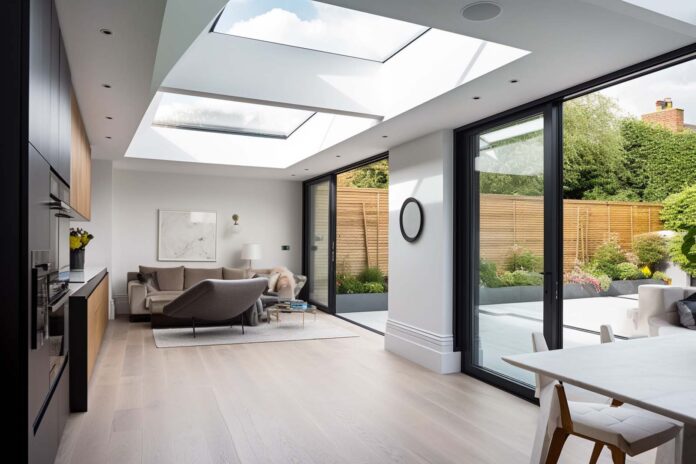
Skylights are becoming increasingly popular in homes and commercial spaces and for good reason. These special windows installed on roofs offer a range of benefits that go beyond looks. They bring in more natural light, improve ventilation, and make spaces more energy efficient. In this blog post, we’ll explore the many advantages of roof windows.
Whether you’re a homeowner or a construction professional, understanding these benefits can help you make smart decisions for your projects. Get ready to discover how rooflights can brighten up spaces, enhance airflow, and save energy. Let’s dive into the world of skylights and see how they can make a big difference.
Enhanced Natural Lighting
Abundant Natural Light
Skylights can help boost your home’s natural lighting, reducing the need for artificial lighting. These cleverly designed windows on the roof act as portals for sunlight, allowing it to flood into the room below. The result is a brighter and more inviting environment that feels connected to the outdoors. Natural light has been proven to positively impact our mood, productivity, and overall well-being, creating a more pleasant living or working space.
Aesthetics and Connection
Beyond the practical benefits, skylights also enhance the aesthetics of a space. They create a unique architectural feature that adds character and visual appeal to both residential and commercial buildings. Picture yourself lying in bed and gazing at the stars through a skylight or working in an office bathed in warm sunlight. Skylights provide captivating views of the sky, changing cloud formations, and even passing birds, establishing a stronger connection with the natural world.
Illuminating Interior Spaces
With skylights, interior spaces that were once dim and gloomy can be transformed into bright and vibrant areas. Whether it’s a dark hallway, a windowless bathroom, or an attic space, rooflights offer a practical solution to bring natural light into these otherwise neglected areas. They help eliminate shadows, create a sense of openness, and make rooms feel more spacious. By harnessing the power of daylight, skylights have the potential to completely change the atmosphere and functionality of a space.
By providing abundant natural light, enhancing aesthetics, and illuminating previously dark areas, skylights offer a multitude of benefits in terms of enhancing natural lighting. The next section will explore how skylights can also improve ventilation in homes and commercial spaces.
Improved Ventilation
Natural Airflow and Freshness
Skylights play a vital role in improving ventilation by facilitating the entry of fresh air and the expulsion of stale air. When skylights are strategically placed, they can act as effective air vents, allowing natural airflow to circulate throughout a space. This natural ventilation helps to remove odours, pollutants, and moisture, promoting a healthier indoor environment. With the opening skylights, you can welcome a refreshing breeze and enjoy the benefits of improved air quality.
Alleviating Stuffy Spaces
In rooms with limited windows or inadequate ventilation, such as bathrooms or kitchens, skylights provide a practical solution. These spaces often accumulate excess moisture and odours, leading to a stuffy and uncomfortable atmosphere. However, by installing skylights in these areas, you can introduce natural ventilation and create a more pleasant environment. The ability to open skylights allows for increased airflow and efficient ventilation, reducing humidity levels and maintaining a fresher, more enjoyable space.
Enhancing Cross Ventilation
Skylights can also be strategically positioned to promote cross-ventilation within a building. By installing skylights in different areas of the roof, you can create a natural airflow pathway. As cool air enters through one skylight, warm air is expelled through another, creating a refreshing and cooling effect. This passive ventilation method reduces the reliance on mechanical systems and improves energy efficiency, all while providing a comfortable and well-ventilated indoor environment.
With their ability to facilitate natural airflow, alleviate stuffy spaces, and enhance cross ventilation, skylights are a valuable asset in improving ventilation. In the next section, we will delve into how skylights contribute to energy efficiency, reducing reliance on artificial lighting and saving on utility costs.
Energy Efficiency
Harnessing Natural Light
One of the key benefits of skylights is their ability to harness natural light, reducing the need for artificial lighting during daylight hours. By introducing sunlight into interior spaces, roof windows help to create a well-lit environment that is both energy-efficient and visually appealing. This reliance on natural light not only lowers electricity usage but also contributes to a more sustainable lifestyle by reducing carbon emissions associated with artificial lighting.
Daylighting for Savings
Skylights play a significant role in a design strategy known as daylighting. This technique involves optimizing the use of natural light to illuminate spaces, minimizing the need for electric lighting. When incorporated thoughtfully, skylights can provide ample illumination, reducing the reliance on energy-consuming light fixtures. This not only translates to lower electricity bills but also extends the lifespan of lighting systems, resulting in cost savings and reduced maintenance.
Energy-Efficient Design
Skylights can be designed with energy efficiency in mind, incorporating features that enhance their performance. For example, rooflights with low-emissivity (Low-E) coatings help control the transfer of heat, preventing excessive heat gain in the summer and heat loss in the winter. Additionally, skylights equipped with thermal breaks and insulated frames improve overall energy efficiency by reducing heat transfer and enhancing the insulation properties of the roof glass.
By harnessing natural light, embracing daylighting strategies, and incorporating energy-efficient design features, rooflights contribute to significant energy savings and a more sustainable built environment. In the following section, we will explore the environmental benefits of skylights and their potential for integrating with renewable energy systems.
Environmental Benefits
Reducing Environmental Impact
Skylights offer numerous environmental benefits that contribute to a more sustainable future. By harnessing natural light, they reduce the need for artificial lighting powered by electricity, thereby lowering energy consumption and decreasing carbon emissions. This reduction in energy usage not only helps combat climate change but also reduces the strain on limited natural resources.
Green Building Certifications
Skylights can play a crucial role in achieving green building certifications and sustainability goals. Organizations like LEED (Leadership in Energy and Environmental Design) recognize the positive impact of skylights on energy efficiency and occupant well-being. By incorporating roof windows into construction projects, builders can earn valuable points towards certification and demonstrate their commitment to environmentally conscious design.
Integration with Renewable Energy
Skylights have the potential to integrate seamlessly with renewable energy systems, such as solar panels. By combining skylights with solar technology, buildings can generate their own clean and renewable energy. The rooflights serve a dual purpose, providing natural light while the solar panels harvest the sun’s energy. This integration offers a powerful synergy that maximizes energy efficiency and reduces reliance on traditional energy sources.
Skylights provide environmental benefits by reducing environmental impact and supporting green building certifications. They also seamlessly integrate with renewable energy systems. In the subsequent section, we will explore important considerations and design factors to ensure optimal performance and installation of skylights.
Considerations and Design Factors
Placement and Orientation
When incorporating skylights, careful consideration should be given to their placement and orientation within a building. Proper placement ensures optimal natural light distribution and minimizes potential glare or heat gain. Assessing the path of the sun throughout the day and the building’s orientation can help determine the ideal location for rooflights to maximize their benefits.
Glazing Options and Shading Devices
Choosing the right glazing options for skylights is crucial to balance light transmission, insulation properties, and solar heat gain. Low-emissivity (low-e) coatings can help control the amount of heat and UV radiation entering space. Additionally, considering the installation of shading devices, such as blinds or shades, can provide further control over light levels and heat gain, especially in regions with intense sunlight.
Installation Techniques and Insulation
Proper installation techniques are essential to ensure the long-term performance and durability of skylights. This includes appropriate flashing details to prevent water leakage, proper sealing to maintain airtightness, and adequate insulation to minimize heat loss or gain. Following manufacturer guidelines and working with experienced professionals during installation is crucial to achieving a weather-tight and energy-efficient roof window system.
Think about skylight placement, pick the right glazing, and ensure good installation and insulation. These are key to getting the most from rooflights. Next, we’ll sum up their perks and inspire you to try roof windows in your own spaces.
In conclusion
Skylights offer a multitude of benefits, enhancing natural lighting, ventilation, and energy efficiency in both residential and commercial spaces. They bring abundant natural light, transforming interiors and creating a connection with the outdoors. Skylights improve ventilation, promoting fresh air circulation and alleviating stuffiness.
Additionally, they reduce reliance on artificial lighting, contributing to energy savings and lower electricity costs. Skylights also offer environmental advantages, reducing carbon emissions and supporting sustainability goals. By considering factors such as placement, glazing options, and installation techniques, the full potential of skylights can be realized.
Embrace the beauty of natural light and the transformative power of skylights to create brighter, healthier, and more sustainable spaces. Choose one of the wide range of different types of skylights available on the market.











